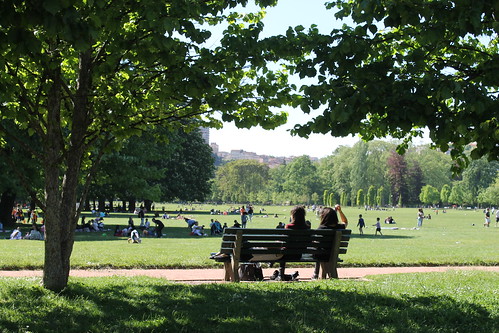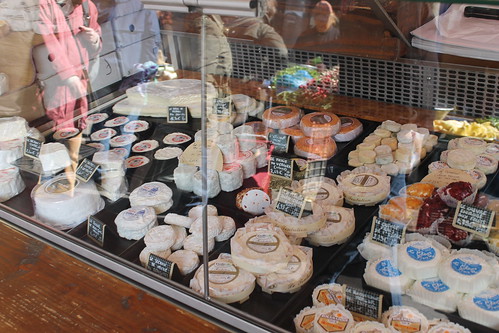It has been five days since we got into Lyon, and we are slowly beginning to learn this French city, walking the hills, crossing the rivers, accustoming our ears to the language, and memorizing the street names.

Our apartment is located in the 6th arrondisement, on the very edge of the upper northeastern corner of Lyon. Our street is bare meters from the dividing line that marks the beginning of Villeurbanne, a neighboring city to our north and east. Some parts of Villeurbanne are distinctly different — three blocks to our north begins the quartier Tonkin, which is some sort of suburban housing development from the ’60s and ’70s. The large apartment buildings resemble ones I’ve seen in China, but with much more geometric, artistic, and interesting architecture.


The Tonkin complex has within a hospital, an elementary school, and some large playgrounds. It really has a flavor of its own, and we really enjoy wandering around this part of town. There is also a large Muslim population in nearby Villeurbanne, which comes out not only in the populace, quite a few of whom wear headscarves, but also in the streetfront kebab restaurants which hang “Hallal” signs above their shop. Due to the May 1 (Labor Day) holiday, many normal restaurants were closed, and as a matter of last recourse, we visited twice a place with I got pretty decent kebab sandwiches (for 4.5 euro, the normal price). Steve ordered a “taco au choix” with steak, which turned out to be a thick burrito with steak, vegetables, and fries inside.

Immediately to our northwest is the Parc de la Tête d’Or, one of the largest urban parks in France, which is very busy — it houses a zoo, a lake, a vélodrome, and a botanic garden with many large greenhouses. It attracts joggers and visitors during any time of year, but on especially nice days, the whole city seems to turn out here. We have been spending time around the botanic garden, trying to find its specimens of Metasequoia glyptostrobides (dawn redwood), which is a tree originally found in China that my dad, a botanist, has made a study of in his career. It looks like there’s a small grove here according to pictures but it has kind of been slow going since it’s a pretty large botanic garden. The other really extraordinary thing about the Parc is that the zoo boasts an African plain, a 2.5 acre expanse that is set off from the rest of the park by a moat and low fence. Inside, you can see many species living in what approximates their natural environment. Yesterday, we watched a herd of white spotted deer graze in the shade along with hundreds of other curious onlookers.

To our west is the part of Lyon known as Brotteaux, which is a fairly wealthy district. There are many older buildings like the one we live in, with large tall airy windows, and ornate stonework and plasterwork on the outside. After twenty or twenty five minutes of walking west, you will come to the Rhone river. The Rhone is an incredibly beautiful river, wide and deep, and a rich shade of jade in the sun. It divides this eastern part of Lyon from hill of Croix-Rousse. Just south of Croix-Rousse is the Prèsqu’ile, which is the center and liveliest part of Lyon, and true to its name, almost an island. The hill of Croix-Rousse is one of the historically working quarters of Lyon. We walked across the Rhone and climbed Croix-Rousse to get to its Saturday market, the largest of its kind in Lyon. It was a bit of a hike, certainly, and by the time we reached the top, we were on eye-level with some of the taller skyscrapers that we could see back across the river. It is amazingly picturesque, and I feel maybe a bit more old fashioned France than where we are living.

The market did not disappoint — it was at least a kilometer long along the Boulevard de la Croix-Rousse, but we didn’t walk the whole expanse. In addition to produce of every kind, we saw butchers and cheesemakers who were parading their wares. There were chickens being roasted whole, and you could also buy the mounds of fingerling potatoes clustered under the chickens, stewing in their juices. There were many rounds of soft homemade cheese from goats and cows, in addition to withered sausages of every imaginable kind. We even saw beautifully glazed donuts and pastries for sale. We loaded up on some green peppers, leeks, nectarines, and a few other things. Most of the produce we got was pretty dirt cheap at 1 euro per kilo, more or less. After a short respite at a nearby café, we took the métro back home, laden down by our purchases.



To our south is the Part-Dieu quartier, dominated by the Gare de Part Dieu, one of Lyon’s main train stations and its TGV connection (train de grand vitesse or high speed rail) with Paris to the north and Marseilles to the south. We took a walk down here this morning to take a look at the bookstores around the train station, and also the mall La Part Dieu, which is probably our closest choice for prêt-a-porter (off the rack) shopping, with stores like H&M, Zara, you name it. We made our way back by walking on the western side of the train tracks, and passed by the Gare des Brotteaux, an old railway station that is very beautiful and stately, resembling the Gare d’Orsay (now the Musée d’Orsay) in Paris. It bears the inscription “Chemins de Fer: Paris-Lyon-Méditeranée”, a testament to the PLM company that originally built it. Today, according to Wikipedia, it houses an auction house. I loved seeing it though, because it’s a great example of the Beaux-Arts architecture that is so typically French. (We didn’t get to take any pictures because I didn’t bring my camera along, but I’ll put up a picture here when I get around to it.)
There’s a lot more to Lyon than we’ve been able to cover on foot from our apartment, but I feel like we’ve made a good start! In particular, I am very excited about seeing Lyon’s historic traboules, located in Vieux Lyon and Croix-Rousse, the Prèsqu’ile, which is the center of Lyon, the area’s largest flea market in Villeurbanne (on Sundays), and of course the other river, the Saône, which lies on the other side of the Prèsqu’ile and Croix-Rousse, and Lyon to the west of that. We’re also industriously making our own food most of the time because paying 10 euro (~14 USD) per person for lunch is just heartbreaking, but we’ll have to make an exception for some of the typically Lyonnais and Asian (in particular, a Taiwanese joint!) restaurants. I hope you guys have enjoyed a little glimpse of Lyon, and will let us know what you want to hear more about from France.
Much more to come,
Connie